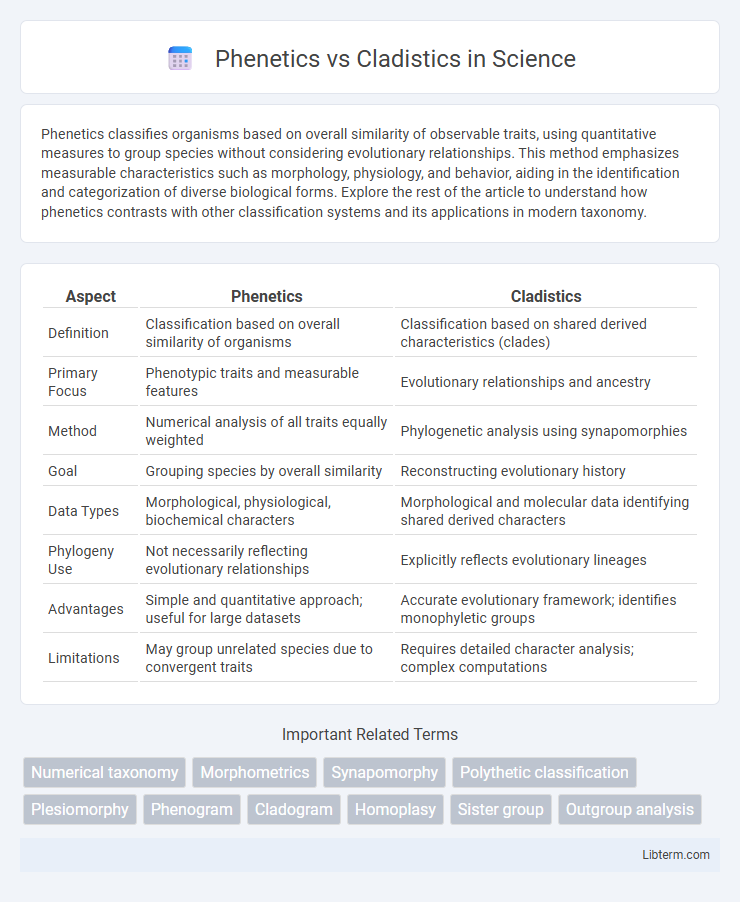Phenetics classifies organisms based on overall similarity of observable traits, using quantitative measures to group species without considering evolutionary relationships. This method emphasizes measurable characteristics such as morphology, physiology, and behavior, aiding in the identification and categorization of diverse biological forms. Explore the rest of the article to understand how phenetics contrasts with other classification systems and its applications in modern taxonomy.
Table of Comparison
| Aspect | Phenetics | Cladistics |
|---|---|---|
| Definition | Classification based on overall similarity of organisms | Classification based on shared derived characteristics (clades) |
| Primary Focus | Phenotypic traits and measurable features | Evolutionary relationships and ancestry |
| Method | Numerical analysis of all traits equally weighted | Phylogenetic analysis using synapomorphies |
| Goal | Grouping species by overall similarity | Reconstructing evolutionary history |
| Data Types | Morphological, physiological, biochemical characters | Morphological and molecular data identifying shared derived characters |
| Phylogeny Use | Not necessarily reflecting evolutionary relationships | Explicitly reflects evolutionary lineages |
| Advantages | Simple and quantitative approach; useful for large datasets | Accurate evolutionary framework; identifies monophyletic groups |
| Limitations | May group unrelated species due to convergent traits | Requires detailed character analysis; complex computations |
Introduction to Phenetics and Cladistics
Phenetics classifies organisms based on overall morphological and genetic similarities without considering evolutionary relationships, using quantitative methods like numerical taxonomy to analyze phenotypic traits. Cladistics groups organisms by shared derived characteristics (synapomorphies) to reconstruct evolutionary lineages, emphasizing common ancestry inferred from phylogenetic trees. Both approaches aim to organize biodiversity, but phenetics relies on measurable similarity while cladistics focuses on evolutionary history.
Historical Development of Classification Methods
Phenetics, developed in the mid-20th century by researchers like Sokal and Michener, focused on classifying organisms based on overall morphological similarity using numerical methods, emphasizing measurable traits without considering evolutionary relationships. Cladistics emerged in the 1950s and gained prominence through the work of Willi Hennig, who introduced a method to classify organisms strictly based on shared derived characteristics (synapomorphies) to reflect evolutionary ancestry and phylogenetic branching patterns. The shift from phenetic to cladistic methods marked a paradigm change, prioritizing evolutionary history and common descent over phenotypic similarity in biological classification.
Fundamental Principles of Phenetics
Phenetics classifies organisms based on overall morphological similarity, using quantitative measurements and numerical methods to analyze traits without considering evolutionary relationships. It relies on phenotypic characters and treats all traits with equal weight to generate phenograms reflecting phenotypic distances. The fundamental principle emphasizes objective, measurable data to group species by observable characteristics rather than inferred common ancestry.
Core Concepts of Cladistics
Cladistics emphasizes the classification of organisms based on shared derived characteristics (synapomorphies) that indicate common ancestry, rather than overall similarity as in phenetics. It uses evolutionary relationships to construct cladograms, which represent branching patterns of lineage divergence. Core concepts include monophyly, parsimony in tree construction, and the distinction between ancestral and derived traits to infer phylogenetic relationships.
Data Types Used in Phenetic and Cladistic Analysis
Phenetic analysis primarily uses overall similarity data derived from measurable morphological traits, molecular sequences, or numeric phenotypic characteristics to construct distance matrices for clustering species based on phenotypic resemblance. Cladistic analysis relies on discrete character states, often genomic DNA sequences or morphological synapomorphies, to infer evolutionary relationships through shared derived characters, emphasizing character polarity and homology rather than overall similarity. The choice of data types influences the methodological focus: phenetics uses continuous or multistate data to measure statistical resemblance, whereas cladistics employs qualitative, character-state data optimized for cladogram topology and phylogenetic inference.
Advantages and Limitations of Phenetics
Phenetics offers a straightforward, quantitative approach by comparing overall similarity among organisms based on measurable traits, making it useful for large datasets and reducing subjective bias in classification. However, its limitation lies in ignoring evolutionary relationships and phylogenetic context, often grouping organisms based on convergent traits rather than shared ancestry. This can result in classifications that do not accurately reflect true evolutionary history, limiting its effectiveness for understanding lineage divergence.
Strengths and Weaknesses of Cladistics
Cladistics offers a robust framework for understanding evolutionary relationships by focusing on shared derived characteristics, providing precise phylogenetic trees that reflect common ancestry. Its strength lies in its ability to generate testable hypotheses about evolutionary pathways and avoid convergent trait confusion common in phenetics. However, cladistics can be limited by incomplete fossil records, homoplasy, and the reliance on accurate character state identification, which may lead to ambiguous or conflicting tree topologies.
Major Differences Between Phenetics and Cladistics
Phenetics classifies organisms based on overall morphological or phenotypic similarities without considering evolutionary relationships, using numerical methods to quantify traits. Cladistics, in contrast, groups species by shared derived characteristics (synapomorphies) to reconstruct evolutionary lineages and emphasize common ancestry. Major differences include phenetics' focus on phenotypic similarity versus cladistics' focus on phylogenetic relationships, and the use of phenograms in phenetics compared to cladograms in cladistics.
Applications in Modern Taxonomy and Systematics
Phenetics classifies organisms based on overall morphological similarities and quantifies traits using statistical methods, aiding in rapid identification and grouping of species in ecological surveys. Cladistics, emphasizing evolutionary relationships and shared derived characteristics (synapomorphies), provides a framework for reconstructing phylogenies essential in modern systematics and biodiversity conservation. Modern taxonomy increasingly integrates cladistic analysis with molecular data, enhancing the accuracy of phylogenetic trees and refining species delineation.
Future Perspectives in Biological Classification
Future perspectives in biological classification emphasize integrating phenetics and cladistics through advanced computational methods and genomic data analysis. Machine learning algorithms enable more precise clustering of organisms based on phenotypic traits while supporting cladistic inference from molecular phylogenies. The convergence of phenetic and cladistic approaches promises enhanced resolution in taxonomy, fostering a comprehensive understanding of evolutionary relationships and biodiversity.
Phenetics Infographic

 libterm.com
libterm.com